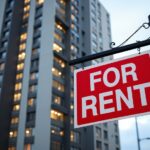Homeowners Association (HOA) fees are another rising home expense as Americans struggle with housing affordability. More properties on the market last year had a homeowners association (HOA) charge, and those fees were more expensive than the previous year, according to a new analysis from Realtor.com.
According to Realtor.com, some 40.5% of for-sale listings in 2024 had a nonzero HOA fee, up from 39.2% the previous year. The median monthly charge was $125, up from $110.
“With a down payment and closing costs up front, and then principal, interest, taxes, and insurance every month after that, purchasing a home is already a financially daunting task, before adding in the rising cost of HOA dues,” said Danielle Hale, Chief Economist at Realtor.com. “Homes like condos, townhouses and new construction single family homes in neighborhoods with ample amenities are more likely to have an HOA fee. For many of these properties, HOA benefits often include a certain amount of maintenance and even utilities that homeowners without an HOA will need to include in their budget. When considering a home with an HOA, buyers should work to understand what benefits it provides like maintenance, security, or communal amenities, and how the HOA fees factor into their overall budget.”
Which Type of Home is More Likely to Have an HOA?
HOA dues are far more likely to apply to newly built properties than to older ones. In 2024, 69.9% of newly constructed homes listed on Realtor.com had a monthly homeowners’ association dues, compared to 37.1% of pre-existing properties.
HOA dues are far more common among listings for condos, rowhomes, and townhomes (henceforth referred to as condos) than single family houses, much like the divisions between new construction and existing homes. In 2024, only 33.6% of single-family homes had HOA dues, compared to 83.8% of condos for sale.
But, in which areas are homebuyers most likely to incur an HOA fee? The answer is: in U.S. regions with a high concentration of condos or new construction, particularly in areas with popular beaches or ski resorts.
The top 10 cities with the highest percentage of for-sale listings that are subject to HOA dues are:
| Metro Area | Share of Listings with HOA | Median Monthly HOA Dues |
| Edwards, CO | 89.9 % | $525 |
| Myrtle Beach-Conway-North Myrtle Beach, SC/NC | 84.8 % | $138 |
| Heber, Utah | 83.3 % | $300 |
| Lakeland-Winter Haven, FL | 79.7 % | $78 |
| Orlando-Kissimmee-Sanford, FL | 78.4 % | $164 |
| Boise City, ID | 77.6 % | $54 |
| Las Vegas-Henderson-Paradise, NV | 77.1 % | $118 |
| Jackson, WY | 77.0 % | $250 |
| Houston-The Woodlands-Sugar Land, Texas | 76.8 % | $67 |
| North Port-Sarasota-Bradenton, FL | 76.0 % | $31 |
In what situations might purchasers avoid having to pay a monthly HOA dues? In smaller markets, primarily in farther inland areas, with fewer recently constructed homes and condominiums.
The top 10 cities with the lowest percentage of for-sale listings that are subject to HOA dues are:
| Metro Area | Share of Listings with HOA | Median Monthly HOA Dues |
| Anniston-Oxford, AL | 3.8 % | $29 |
| Elizabethtown-Fort Knox, KY | 5.0 % | $19 |
| Jonesboro, AR | 5.3 % | $36 |
| Monroe, LA | 5.8 % | $30 |
| Huntington-Ashland, WV, Ohio, KY | 6.1 % | $25 |
| Albany-Lebanon, OR | 6.2 % | $33 |
| Merced, CA | 6.2 % | $137 |
| Ukiah, CA | 6.5 % | $131 |
| Vineland-Bridgeton, NJ | 6.8 % | $77 |
| Orangeburg, SC | 7.1 % | $104 |
While HOAs are nearly unavoidable in some metro areas, are you willing to pay HOA costs that come with homeownership?
To read the full report, including more data, charts, and methodology, click here.








